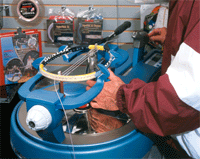|
|

The Trampoline Effect and String Tension Strategy
By Steve Crandall
Vice President, Sales & Marketing
Ashaway Racket Strings

Getting 'the same tension' is not as easy as it sounds. Different types and makes of machines will tension strings differently. For example, you'll typically get about 10% higher tension with an electronic machine than with a manual machine, even when they're both set to the same weight. Plus, stringing machines - no matter their type - need to be frequently calibrated in order to perform up to specification. |
Rod Gilmour made some very interesting points about string tension in his latest "String Matters" column in the UK's Squash Player magazine (SP Volume 41, 2013, Issue 6, International Edition). In the column he talked to UK racquet stringer Liam Nolan about why, during the recent World Championships in Manchester, UK, finalist Gregory Gaultier strung his racquet at an amazingly low 15 lbs. tension, which is about half of the normal 28 lbs. tension used by today's top level squash players.
He did it for power, said Nolan. Stringing that low means, "There will be a lot of trampoline effect coming off his racket and it will come off faster." Daryl Selby was a victim of this in his quarter-final loss to Gaultier. Said Nolan, "The ball was going so fast he couldn't actually see it. He could hear it, though!"
The 'trampoline effect' is a term often used in racquet sports, and often misunderstood. It's part of the old rubric, string loose for power, tight for control, and it means, simply, that looser strung strings can stretch more, and thus, impart more power to the ball. But this power comes at the cost of control, especially in a game like squash where there are so many wall and drop shots that cannot be played on the sweet spot of the racquet.
Think about bouncing on a trampoline for a minute and you'll see how this works. If you bounce in the center of the trampoline, you tend to go straight up and back down. But if you bounce off from one side, your body tends to be thrown off into the opposite direction. The same thing happens to the ball when you return a wall or a drop shot. And the looser your racquet is strung, the more pronounced this effect will be.
That's why, as Nolan said, very few players could benefit from stringing as low as Gaultier did. "They just don't have the skills that Greg does." And that's also why you shouldn't try to mimic the pros or other players in your club in your stringing tension: it's too individual a choice. Rather, you should experiment with a number of tensions to achieve a balance of power and control that suits your particular game.
This is especially true if you play with different types of string. Different string materials respond to tension in different ways. Some materials are more elastic and will act differently than others even when strung to the same tension, and different materials loose tension at different rates. So even if you string at your "ideal" tension, your racquet won't stay that way. For example, Nylon loses tension more rapidly than Zyex® based strings after stringing, and Zyex remains at a steady state much longer.
The way strings are constructed is also a factor. For instance, a solid monofilament string will be stiffer when the ball hits the string bed than a string that has a smaller monofilament core with one, two or three wraps of smaller filaments around it. There will be more elasticity to the monofilament core type, since it is a thinner core. On the other hand, a multifilament string, which could have over a thousand separate filaments, will stretch more when the ball is hit. That means you'll get more power at the same tension.
But to make matters more complicated, even getting 'the same tension' is not as easy as it sounds. Different types and makes of machines will tension strings differently. For example, you'll typically get about 10% higher tension with an electronic machine than with a manual machine, even when they're both set to the same weight. Plus, stringing machines - no matter their type - need to be frequently calibrated in order to perform up to specification.
Bottom line, if you're serious about getting the most from your racquet, you need to look at string tension strategically. You not only need to know what string works best for you at what tension, you need to know when that tension "peaks" in your frame, i.e., do you restring a week before a tournament or the day before? You need to be sure your racquet is strung on the same type of machine (the same stringer helps, too!), and that the machine is actually stringing at the tension it says it's stringing.
This article previously appeared in Squash Magazine.
|